Information injection-pump assembly
ZEXEL
106871-8981
1068718981
HINO
220007721A
220007721a
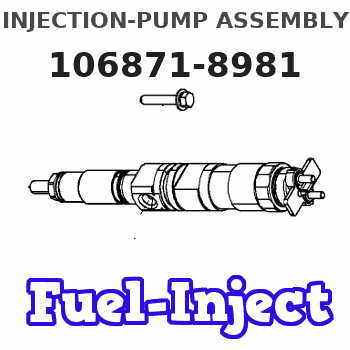
Rating:
Service parts 106871-8981 INJECTION-PUMP ASSEMBLY:
1.
_
7.
COUPLING PLATE
8.
_
9.
_
11.
Nozzle and Holder
23600-2430B
12.
Open Pre:MPa(Kqf/cm2)
14.7{150}/21.6{220}
14.
NOZZLE
Include in #1:
106871-8981
as INJECTION-PUMP ASSEMBLY
Cross reference number
ZEXEL
106871-8981
1068718981
HINO
220007721A
220007721a
Zexel num
Bosch num
Firm num
Name
Calibration Data:
Adjustment conditions
Test oil
1404 Test oil ISO4113 or {SAEJ967d}
1404 Test oil ISO4113 or {SAEJ967d}
Test oil temperature
degC
40
40
45
Nozzle and nozzle holder
105780-8140
Bosch type code
EF8511/9A
Nozzle
105780-0000
Bosch type code
DN12SD12T
Nozzle holder
105780-2080
Bosch type code
EF8511/9
Opening pressure
MPa
17.2
Opening pressure
kgf/cm2
175
Injection pipe
Outer diameter - inner diameter - length (mm) mm 8-3-600
Outer diameter - inner diameter - length (mm) mm 8-3-600
Overflow valve
134424-0820
Overflow valve opening pressure
kPa
127
107
147
Overflow valve opening pressure
kgf/cm2
1.3
1.1
1.5
Tester oil delivery pressure
kPa
157
157
157
Tester oil delivery pressure
kgf/cm2
1.6
1.6
1.6
Direction of rotation (viewed from drive side)
Right R
Right R
Injection timing adjustment
Direction of rotation (viewed from drive side)
Right R
Right R
Injection order
1-8-6-2-
7-5-4-3
Pre-stroke
mm
4.8
4.74
4.8
Beginning of injection position
Drive side NO.1
Drive side NO.1
Difference between angles 1
Cal 1-8 deg. 45 44.75 45.25
Cal 1-8 deg. 45 44.75 45.25
Difference between angles 2
Cal 1-6 deg. 90 89.75 90.25
Cal 1-6 deg. 90 89.75 90.25
Difference between angles 3
Cyl.1-2 deg. 135 134.75 135.25
Cyl.1-2 deg. 135 134.75 135.25
Difference between angles 4
Cal 1-7 deg. 180 179.75 180.25
Cal 1-7 deg. 180 179.75 180.25
Difference between angles 5
Cal 1-5 deg. 225 224.75 225.25
Cal 1-5 deg. 225 224.75 225.25
Difference between angles 6
Cal 1-4 deg. 270 269.75 270.25
Cal 1-4 deg. 270 269.75 270.25
Difference between angles 7
Cal 1-3 deg. 315 314.75 315.25
Cal 1-3 deg. 315 314.75 315.25
Injection quantity adjustment
Adjusting point
A
Rack position
8.9
Pump speed
r/min
700
700
700
Average injection quantity
mm3/st.
139.3
137.3
141.3
Max. variation between cylinders
%
0
-2
2
Basic
*
Fixing the lever
*
Injection quantity adjustment_02
Adjusting point
B
Rack position
8.95+-0.
5
Pump speed
r/min
1100
1100
1100
Average injection quantity
mm3/st.
133.1
129.1
137.1
Fixing the lever
*
Injection quantity adjustment_03
Adjusting point
F
Rack position
3.8+-0.5
Pump speed
r/min
225
225
225
Average injection quantity
mm3/st.
10.4
7.4
13.4
Max. variation between cylinders
%
0
-15
15
Fixing the rack
*
Injection quantity adjustment_04
Adjusting point
G
Rack position
-
Pump speed
r/min
100
100
100
Average injection quantity
mm3/st.
139
139
Fixing the lever
*
Remarks
After startup boost setting
After startup boost setting
Timer adjustment
Pump speed
r/min
750--
Advance angle
deg.
0
0
0
Load
1/4
Remarks
Start
Start
Timer adjustment_02
Pump speed
r/min
700
Advance angle
deg.
0.3
Load
1/4
Timer adjustment_03
Pump speed
r/min
820--
Advance angle
deg.
0.7
0.4
1
Load
4/4
Timer adjustment_04
Pump speed
r/min
900+50
Advance angle
deg.
0.7
0.4
1
Load
3/4
Timer adjustment_05
Pump speed
r/min
1100-50
Advance angle
deg.
5.25
4.95
5.55
Load
4/4
Remarks
Finish
Finish
Test data Ex:
Governor adjustment
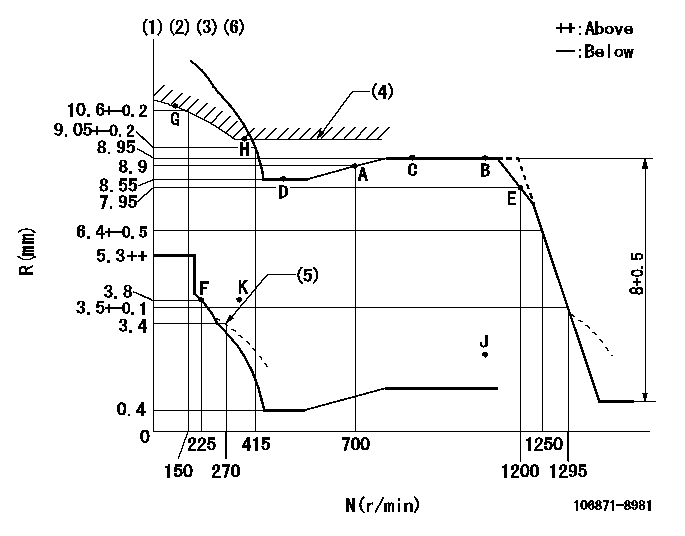
N:Pump speed
R:Rack position (mm)
(1)Lever ratio: RT
(2)Target shim dimension: TH
(3)Tolerance for racks not indicated: +-0.05mm.
(4)Excess fuel setting for starting: SXL
(5)Damper spring setting
(6)Set idle at point K (N = N1, R = R1) and confirm that the injection quantity does not exceed Q1 at point J (N = N2).
----------
RT=0.8 TH=2.7mm SXL=10.25+-0.1mm N1=325r/min R1=3.8mm N2=1100r/min Q1=3mm3/st
----------
----------
RT=0.8 TH=2.7mm SXL=10.25+-0.1mm N1=325r/min R1=3.8mm N2=1100r/min Q1=3mm3/st
----------
Speed control lever angle
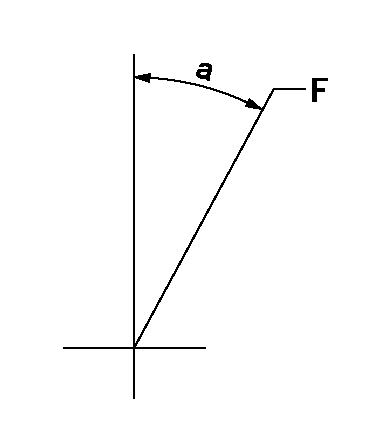
F:Full speed
----------
----------
a=15.5deg+-5deg
----------
----------
a=15.5deg+-5deg
0000000901

F:Full load
I:Idle
(1)Use the hole at R = aa
(2)Stopper bolt setting
----------
aa=42mm
----------
a=39deg+-5deg b=43.5deg+-3deg
----------
aa=42mm
----------
a=39deg+-5deg b=43.5deg+-3deg
Stop lever angle
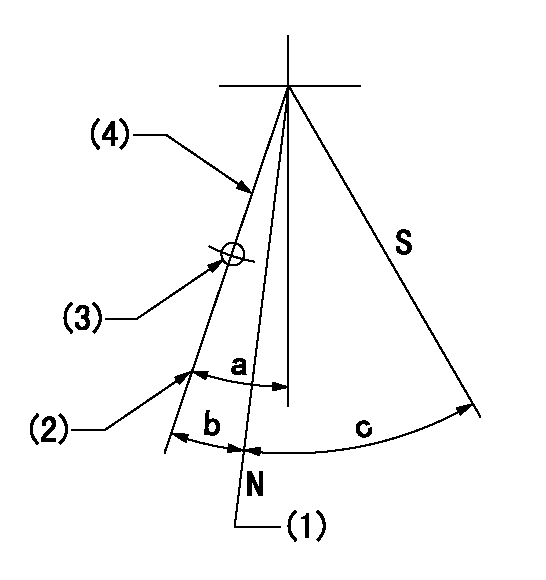
N:Pump normal
S:Stop the pump.
(1)Rack position = aa (at delivery), set before governor adjustment
(2)Set the stopper bolt (apply red paint).
(3)Use the pin at R = bb
(4)Lever free
----------
aa=12+-0.1mm bb=37mm
----------
a=(9deg)+-5deg b=9deg+-5deg c=35deg+-5deg
----------
aa=12+-0.1mm bb=37mm
----------
a=(9deg)+-5deg b=9deg+-5deg c=35deg+-5deg
Timing setting
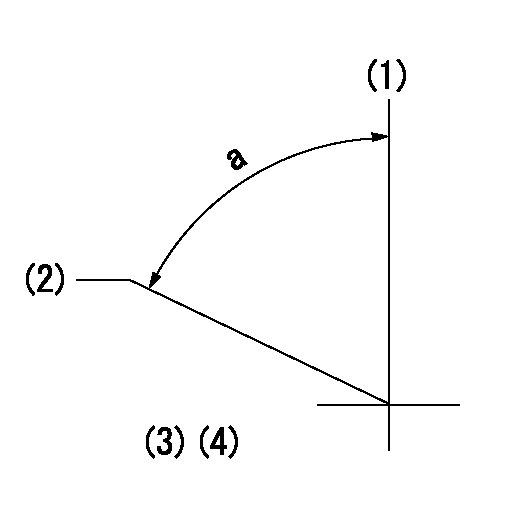
(1)Pump vertical direction
(2)Coupling's key groove position at No 1 cylinder's beginning of injection
(3)-
(4)-
----------
----------
a=(80deg)
----------
----------
a=(80deg)
Information:
Fuel consumption complaints are related to engine owners expectations. They may often times be related to the engine itself, causes other than the engine, and in some cases the fuel consumption may be normal for the application. Only a good discussion with the owner/operator, as described in the Owner/Operator Input section, will give guidance as to a correct repair or to prevent unnecessary repairs.Owner/Operator Input
The following are some of the questions which should be asked before beginning any diagnosis or repair for an engine performance complaint. There Are No Hard And Fast Answers For These Questions. There are many factors that can cause poor fuel mileage or make users believe they are getting fuel-poor-mileage.There are also a variety of customer expectations which are acceptable. The answers to these questions will give you a better understanding and perspective on the complaint and may identify characteristics which will help pinpoint the cause of the complaint quickly.1. Are miles measured accurately?A most common problem in determining mpg is errors in recording the number of miles traveled.A. Is this vehicle hub or cab odometer accurate? The easiest way to check an odometer is to install a hub odometer known to be accurate and for the tire size on the truck. Run the truck over several hundred miles and compare the reading with the original odometer.Odometers may also be checked by comparing them to interstate mile posts or by running over a course of known length-a 50-mile run is required to get a good check.B. Are "book miles" or "driver-paid miles" correct? Another way in which miles for mpg calculations are obtained by a fleet is the use of "book miles" or "driver-paid miles." The use of this system can short mileage accumulation by 10 to 15%; thus, mpg is low by 10 to 15%.C. Is the vehicle used for pick-up and delivery operation? Another problem affecting mileage accumulation in many fleets is the use of linehaul equipment for pickup and delivery operations. In the "book mile" system, the truck rarely gets credit for any miles run in pick-up and delivery.2. Is fuel measurement accurate?There are a number of ways in which fuel measurement can be the source of mpg problems.A. Are fuel pumps calibrated? If fuel tickets come from company-owned fuel pumps, there can be errors because nonrevenue fuel pumps do not have calibration requirements in many states.B. Are road fuel tickets accurate? The only way to verify fuel additions when road fuel tickets are used is a laborious ticket-by-ticket audit ensuring that the correct amount of fuel has been entered for the vehicles in question and that there are no indications of incorrect entries.C. Are tank-full mileage checks correctly done? The big problem in "tank-full" checks is getting the tank filled to the same level before and after the user "checked the mileage." With two 100 gallon tanks, errors of 5 to 10 gallons are very common in topping off tanks because of the way truck tanks crossfeed with a relatively
The following are some of the questions which should be asked before beginning any diagnosis or repair for an engine performance complaint. There Are No Hard And Fast Answers For These Questions. There are many factors that can cause poor fuel mileage or make users believe they are getting fuel-poor-mileage.There are also a variety of customer expectations which are acceptable. The answers to these questions will give you a better understanding and perspective on the complaint and may identify characteristics which will help pinpoint the cause of the complaint quickly.1. Are miles measured accurately?A most common problem in determining mpg is errors in recording the number of miles traveled.A. Is this vehicle hub or cab odometer accurate? The easiest way to check an odometer is to install a hub odometer known to be accurate and for the tire size on the truck. Run the truck over several hundred miles and compare the reading with the original odometer.Odometers may also be checked by comparing them to interstate mile posts or by running over a course of known length-a 50-mile run is required to get a good check.B. Are "book miles" or "driver-paid miles" correct? Another way in which miles for mpg calculations are obtained by a fleet is the use of "book miles" or "driver-paid miles." The use of this system can short mileage accumulation by 10 to 15%; thus, mpg is low by 10 to 15%.C. Is the vehicle used for pick-up and delivery operation? Another problem affecting mileage accumulation in many fleets is the use of linehaul equipment for pickup and delivery operations. In the "book mile" system, the truck rarely gets credit for any miles run in pick-up and delivery.2. Is fuel measurement accurate?There are a number of ways in which fuel measurement can be the source of mpg problems.A. Are fuel pumps calibrated? If fuel tickets come from company-owned fuel pumps, there can be errors because nonrevenue fuel pumps do not have calibration requirements in many states.B. Are road fuel tickets accurate? The only way to verify fuel additions when road fuel tickets are used is a laborious ticket-by-ticket audit ensuring that the correct amount of fuel has been entered for the vehicles in question and that there are no indications of incorrect entries.C. Are tank-full mileage checks correctly done? The big problem in "tank-full" checks is getting the tank filled to the same level before and after the user "checked the mileage." With two 100 gallon tanks, errors of 5 to 10 gallons are very common in topping off tanks because of the way truck tanks crossfeed with a relatively